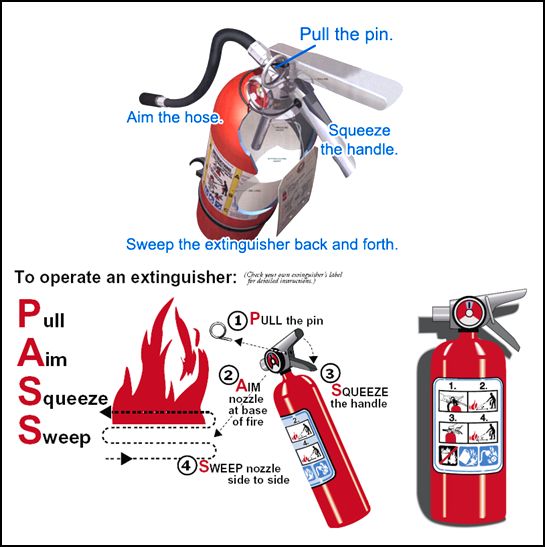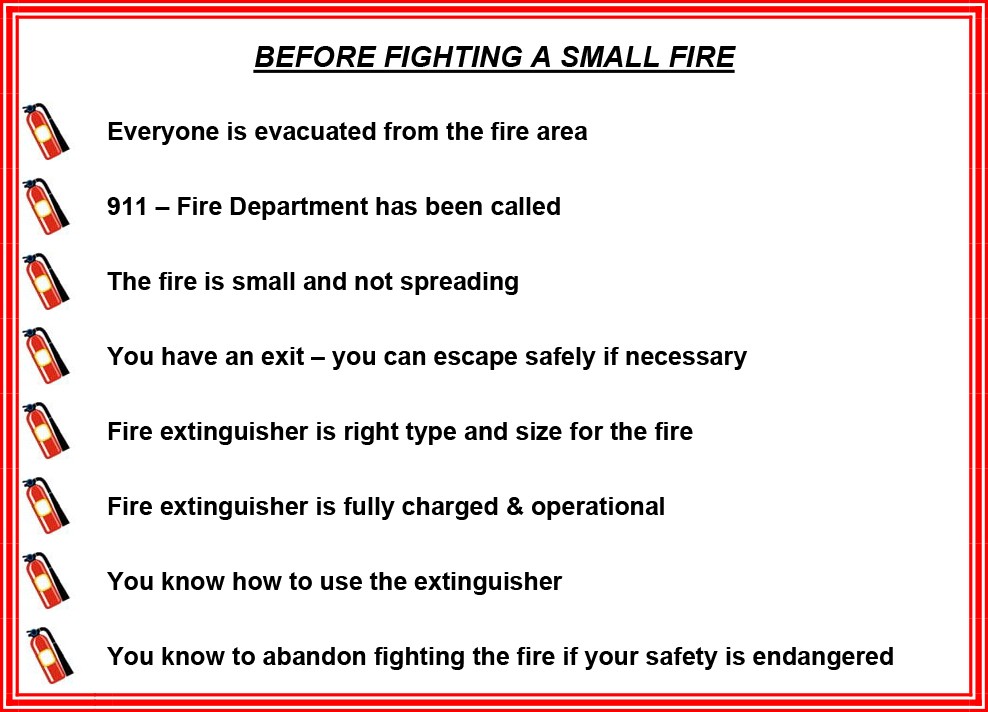Used properly, a portable fire extinguisher can save lives and property by putting out a small, contained fire or containing it sufficiently to allow escape. Fire extinguishers are considered first aid equipment for controlling and putting out small fires before they become large ones. However, they are no substitute for the fire department. Having the proper fire extinguisher, as well as knowing how to use it and how not to use it is important in safeguarding your family and your household.
The first rule of firefighting is to save lives first, and property second! Get yourself and your family to safety before attempting to extinguish any fire. Only if you can do so without endangering yourself or others should you use firefighting aids on hand. Remember, objects can be replaced, people can’t! Never re-enter a burning building – GET OUT & STAY OUT!
Know when to go. Fire extinguishers are only one element of a home fire response plan, but the primary element is safe escape of all occupants. Every household should have a home fire escape plan and working smoke alarms. Never try to fight a fire if it puts you or others in danger!
Selecting the proper fire extinguisher for your home is as simple as A, B, C. There are three basic classes of fires. Portable fire extinguishers that have been tested and approved will be labelled with the class or classes of fire they are suited to fight. There are two standard labelling systems. New fire extinguisher labelling shows a picture to identify the class of fire they’re capable of extinguishing. A slash through any of the symbols tells you the extinguisher cannot be used on that class of fire.
Extinguisher Labels
The older labelling system uses simple icons with an A, B or C designation to show, which class or classes of fire it is safe to use a given extinguisher to fight.

The newer labelling system uses standard pictorial symbols, which show the class or classes of fire for which the extinguisher is suited. The symbols identify the type of fire the extinguisher can be used for.

Note: A red slash stroked through any of the fire classification symbols means it is unsafe to use that extinguisher on that class of fire. For example, a water-filled extinguisher would show the symbols for Class B and C fires slashed through, as water should never be used to extinguish a flammable liquid or an electrical fire.

If a symbol is not shown on the extinguisher’s label, it simply means the extinguisher was not tested for that class of fire.
Fire Extinguisher Ratings
The labels below show the old icon on the left and the new label on the right.

Class A Extinguishers will put out fires in ordinary combustibles, such as wood and paper. The numerical rating for this class of fire extinguisher refers to the amount of water or dry chemical the fire extinguisher holds and the amount of fire it will extinguish.

Class B Extinguishers should be used on fires involving flammable liquids, such as kitchen grease, gasoline, kerosene, paint, oil, etc. The numerical rating for this class of fire extinguisher states the approximate number of square feet of a flammable liquid fire that a non-expert person can expect to extinguish.
NEVER USE WATER

Class C Extinguishers are suitable for use on fires involving electrical equipment or wires. This class of fire extinguishers does not have a numerical rating. The presence of the letter “C” indicates that the extinguishing agent is non-conductive.
NEVER USE WATER
Types of Fire Extinguishers
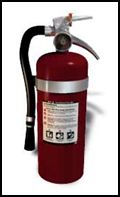

Multi-purpose – Dry Chemical
These extinguishers are usually rated for multiple-purpose use. They contain an extinguishing agent and use a compressed, non-flammable gas as a propellant. Dry chemical extinguishers are usually rated for class B and C fires and may be marked multiple purpose for use in A, B, and C fires.
Dry chemical extinguishers put out fires by coating the fuel with a thin layer of fire retardant powder, separating the fuel from the oxygen. The fire retardant powder works by suffocating the fire, inhibiting the release of combustible vapours and interrupting the combustion chain reaction, which makes these extinguishers extremely effective.
ABC fire extinguishers are red in colour, and range in size from 2.27 kg to 9 kg (5 to 20 pounds).
Dry Chemical extinguishers will have a label indicating they may be used on class A, B, and/or C fires.


Water – Air-pressurized Water (APW)
These extinguishers contain water and compressed air and should only be used on Class A (ordinary combustibles) fires.
Water is one of the most commonly used extinguishing agents for type A fires. You can recognize an APW by its large silver container. They are filled about two-thirds of the way with ordinary water, then pressurized with air. In some cases, detergents are added to the water to produce a foam. They stand about .6 to 1 metre tall (2 to3 feet) and weigh approximately 11.5 kg (25 pounds) when full.
APWs extinguish fire by cooling the surface of the fuel to remove the “heat” element of the fire triangle.
APWs are designed for Class A (wood, paper, cloth, upholstery, rubber, and certain plastics) fires only.
Important:
- Never use water to extinguish flammable liquid fires (Class B). Water is extremely ineffective at extinguishing this type of fire and will make matters worse by the spreading the fire.
- Never use water to extinguish an electrical fire (Class C). Water is a good conductor and may lead to electrocution if used to extinguish an electrical fire. Electrical equipment must be unplugged and/or de-energized before using a water extinguisher on an electrical fire.
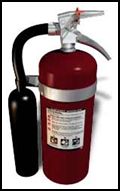

Carbon Dioxide (CO2)
These extinguishers are most effective on Class B and C (liquids and electrical) fires. This type of extinguisher is filled with Carbon Dioxide (CO2) gas, a non-flammable gas under extreme pressure. These extinguishers put out fires by displacing oxygen, or taking away the oxygen element of the fire triangle. Because of its high pressure, when you use this extinguisher pieces of dry ice shoot from the horn, which also has a cooling effect on the fire.
Since the gas disperses quickly, these extinguishers are only effective from 1 to 2-1/2 metres (3 to 8 feet). Since the fire could re-ignite, continue to apply the agent even after the fire appears to be out.
You can recognize this type of extinguisher by its hard horn and lack of pressure gauge.
CO2 cylinders are red and range in size from 2.27 kg to 45.36 kg (5 to 100 pounds) or larger.
CO2 extinguishers are designed for Class B and C (flammable liquid and electrical) fires only.
Important:
- CO2 is not recommended for Class A fires because they may continue to smoulder and re-ignite after the CO2 dissipates.
- Never use CO2 extinguishers in a confined space while people are present without proper respiratory protection.
Choosing a Fire Extinguisher
Before you invest in one or more fire extinguishers, consider where you need them. Where are fires most likely to start? What type of fire would be most likely? Not all fire extinguishers work on all types of fires. Make sure you select an extinguisher that can be easily handled by all family members. Purchase extinguishers listed by a nationally accepted testing laboratory, such as Underwriters Laboratories of Canada (ULC).
A 2.27 kg (5 pound) Multi-purpose Dry Chemical fire extinguisher (Class 3-A, 10-B, C) is recommended for home use since it can be used on class A, B and C fires, which we may experience in our homes. The smallest fire extinguisher you should have for your home is a 1.13 kg (2.5 pound) Multi-purpose Dry Chemical fire extinguisher for installation in the kitchen.Smaller fire extinguishers that fit in nicely with your kitchen decor may not be up to the challenge of putting out a typical fire, since they can be completely discharged in as little as 8 seconds. Cooking oil fires in a pan can be snuffed out without a fire extinguisher by using a tight fitting pot lid and turning off the heat source. Discharging an extinguisher closer than 1.8 to 2.4 metres (6 to 8 feet) from the pan may spread the fire. Remember, the size of the extinguisher is directly related to the size of fire that you can extinguish.
Location of Fire Extinguishers
Fire extinguishers should be installed where the potential fire risk is greatest in the home. A Multi-purpose Dry Chemical fire extinguisher should be installed in the kitchen, laundry, workshop, garage and the top of the basement stairwell in the home. Extinguishers should never be more than 23 metres (75 feet) away from a Class A (ordinary combustibles) hazard, or further than 15 metres (50 feet) away from a Class B (flammable liquids) hazard.
Keep extinguishers in a visible location, high on a wall out of the reach of children, near an exit and away from heat sources. If exposed to heat, the fire extinguisher’s contents may become less effective or cause the extinguisher to lose its charge more quickly. The best location in most situations is just inside a door or entrance, out of the reach of children. Use mounting brackets, if provided with the fire extinguisher. Avoid locating an extinguisher right next to where a fire could develop. Smoke, heat or flames from a fire may prevent you from reaching the extinguisher.
Only adults should handle and use fire extinguishers. Be sure that everyone in the family knows where they are located and how to use them.
Fire Extinguisher Maintenance
Follow the manufacturer’s instructions for care and maintenance. Rechargeable models must be serviced and recharged after every use. A partially discharged fire extinguisher is always considered an empty one. Have it refilled or replaced immediately. Disposable fire extinguishers can only be used once and must be replaced after use. Most fire equipment service companies will not recharge a fire extinguisher with a plastic head assembly, since they find they aren’t reliable in holding a charge. Check with your local fire equipment service company in the Yellow Pages under “Fire Extinguishers”.
Monthly Maintenance Checks:
- Check to ensure that nothing is blocking immediate access to your fire extinguisher. Remove any obstructions.
- Check to ensure your extinguisher is at the recommended operating pressure, indicated by the needle in the green zone on extinguishers equipped with a gauge. Have the extinguisher recharged if the needle is not in the green zone of the gauge.
- Check the hose or nozzle for cracks, tears or blockage by debris. If damage is found, have the extinguisher repaired by a qualified service technician or replaced
- Check the pin and tamper seal to ensure they are intact. If the tamper seal is broken or the pin is missing, have the extinguisher serviced by a qualified service technician.
- Check to ensure the handle or lever is undamaged. If the handle or lever is wobbly or broken, have the extinguisher inspected and repaired by a qualified service technician.
- Check the extinguisher for dents, leaks, rust, chemical deposits and/or other signs of abuse or wear. If damage is found, have the extinguisher repaired by a qualified service technician or replaced.
- Remove the extinguisher from its mounting bracket, turn the extinguisher upside down and hit the bottom sharply with your hand, then shake it well. This will prevent the dry chemical powder from settling or packing down in the cylinder, making it ineffective.
Note the date of the monthly inspection on the inspection tag attached to your fire extinguisher.
When to Replace a Fire Extinguisher
Most fire extinguishers have a lifespan of 5 to 15 years, if properly handled and maintained. Check the label on the fire extinguisher for the location of the date of manufacture. Most newer extinguishers have the year of manufacture stamped on the bottom of the cylinder. Disposable fire extinguishers can be used only once and must be replaced after use. Rechargeable Dry Chemical fire extinguishers must be hydrostatically tested and recharged by a qualified service technician every six years. SeeMonthly Fire Extinguisher Check for additional service or replacement requirements.
If You Discover a Fire
If You Discover a Fire – remember the acronym RACE!
Rescue anyone in immediate danger of the fire, if you can do so safely.
Alert others and emergency services to the fire. Activate the building’s fire alarm, if equipped. Yell “Fire” to warn occupants to evacuate. Call 911 to alert the fire department; always call from a safe location away from the fire.
Contain the spread of fire by closing windows and doors as you evacuate the area and building.
Evacuate to a safe place outside; preferably a pre-arranged meeting place.
Using Your Portable Fire Extinguisher
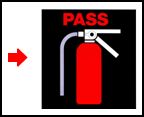 It’s easy to remember how to use a fire extinguisher if you can remember the acronym PASS, which stands for Pull, Aim, Squeeze, and Sweep. Most portable fire extinguishers work according to these directions, but some do not. Read and follow the directions on your extinguisher.
It’s easy to remember how to use a fire extinguisher if you can remember the acronym PASS, which stands for Pull, Aim, Squeeze, and Sweep. Most portable fire extinguishers work according to these directions, but some do not. Read and follow the directions on your extinguisher.
Always call the fire department (911) immediately before attempting to extinguish a fire!

Pull the pin. Some models require you to remove a locking pin on the handle or lever. Some models may have other lever-releasing mechanisms, such as a button.
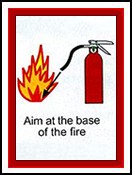
Aim low and direct the hose nozzle or cone at the base of the fire. If you aim at the flames, which most inexperienced users are tempted to do, the extinguishing agent will flow right through the flames, and be ineffective. You want the extinguishing agent to hit the base of the fire. Follow the manufacturer’s instructions on the safe distance from which to fight the fire. Most portable fire extinguishers must be used from a distance of 1.8 to 3 metres (6 to 10 feet) to be effective.
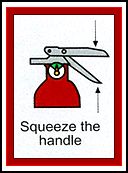
Squeeze the lever above the handle to discharge the extinguishing agent. Releasing the lever will stop the discharge. Some models may have a button instead of a lever.
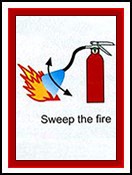
Sweep the nozzle or hose from side to side at the base of the fire. Moving carefully toward the fire, keep the extinguisher aimed at the base of the fire and sweep back and forth until the flames appear to be out. Never turn your back on a fire; watch the fire area in case the fire re-ignites, and repeat use of the extinguisher if necessary.
Always have the fire department inspect the fire site, even if you’re sure you’ve extinguished the fire. The fire department will check to ensure there has not been any spread of fire beyond the original ignition site.
Before Fighting a Small Fire
Don’t attempt to fight a small, contained fire unless you:
- Evacuate all people from the area of the fire.
- Ensure that someone has called 911 to alert the fire department. An extinguisher is no substitute for the fire department.
- The fire is small and not spreading.
- Ensure you can get out fast if you can’t control the fire. Don’t get trapped. Make sure the fire is not between you and your escape. Always keep an exit at your back!
- Ensure you have the right extinguisher for the type and size of fire.
- Ensure your extinguisher is fully charged and in proper working order (monthly inspections).
- Know how to use your fire extinguisher. It’s too late to read the instructions when the fire is burning. If you are unsure on how to use your fire extinguisher or do not feel confident in using it, evacuate immediately, closing doors and windows as you exit.
- Never endanger yourself or others in trying to extinguish a fire.
- If you try to use a fire extinguisher on a fire and the fires does not immediately die down, or if the smoke becomes a major problem, drop the extinguisher and leave the area, closing the door to the area behind you to confine the fire. “Immediately” means within 8 or 10 seconds, the time it takes for most home fire extinguishers to empty.
Never Fight a Fire If...
Fires can be extremely dangerous and you should always be certain that you would not endanger yourself or others when attempting to put out a fire.
Never fight a fire if:
- You don’t know what’s burning. If you don’t know what is burning you don’t know what type of extinguisher to use. Even if you have a multi-purpose ABC fire extinguisher, there may be something in the fire that could explode or produce highly toxic smoke. If you don’t know what is burning, let the fire department handle it.
- The fire appears to be too large to handle with one extinguisher. If you’ve emptied the extinguisher on the fire and the fire continues – evacuate immediately. Do not look for another extinguisher! Evacuate the building immediately, closing doors and windows behind you to reduce the spread of fire.
- The fire is spreading rapidly beyond the spot where it started. The time to use an extinguisher is in the beginning stages of a fire. Fire doubles in size every minute and can spread rapidly. If the fire is already spreading quickly, it is best to evacuate the building immediately, closing doors and windows behind you to reduce the spread of fire.
- You don’t have an adequate or appropriate fire extinguisher. If you don’t have the correct type or large enough extinguisher to put out the fire, it is best not to try to fight the fire. Evacuate the building immediately, closing doors and windows behind you to reduce the spread of fire.
- You might inhale toxic smoke. Any type of fire will produce some amount of carbon monoxide. When synthetic materials, such as nylon in carpeting or foam padding in a couch burn, they can produce highly toxic gases such as hydrogen cyanide, acrolein and ammonia, in addition to carbon monoxide. These gases can be fatal in very small amounts.
- Your instincts tell you not to. If you are uncomfortable with the situation, for any reason, or do not feel confident in using the fire extinguisher properly and safely, do not attempt to fight the fire. Call the fire department and let the professionals handle the emergency.



